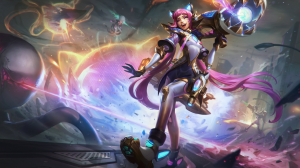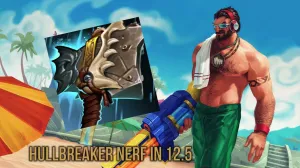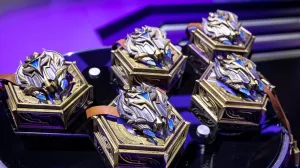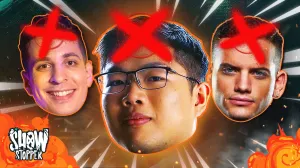Ever since the first Teamfight Tactics tournament, the game has gone through an identity crisis. From open entry tournaments at TwitchCon, to content creator invitationals, to the current world championship, the esports scene has gone through various phases throughout its three-year lifespan. But at its core, no one knows where the scene is heading. In fact, most people don’t even know the TFT esports scene exists. Simply put, TFT desperately needed a counselor — three months ago, it finally got one.
Michael Sherman, the new global esports director for TFT as well as Legends of Runeterra and the unreleased fighting game Project L, has been tasked with trying to figure out TFT’s identity when it comes to its place in Riot’s esports ecosystem. And with eight years of experience, Sherman’s philosophy will guide TFT esports in a new and exciting direction for years to come.
I’m super excited to announce that I’ve started a new role as the Global Head of Esports for TFT, LoR, and Project L. I’m extremely passionate about building esports alongside the community, and that will remain one of my top priorities moving into this new role. pic.twitter.com/cRZsTfGOFO
— Michael Sherman (@RiotSherman) June 15, 2022
Despite the TFT esports scene having no real face up to this point, the competitive scene has been steady over the last couple of years, but Sherman knew that there needed to be a philosophical change when it comes to why they are holding events in the first place.
“The key to the future of TFT is substantially increasing the number of competitive opportunities for players,” Sherman said. “I really believe in a world where if you want to take TFT as a competitive venture that it’s something that is [approachable].”
Essentially, this means more tournaments —and more players. Open qualifier tournaments are a debated topic, but when it comes to fostering player base growth, and those who want a chance to play competitively , Sherman thinks this is the best way forward.
“We toss around the World Series of Poker format a lot; and actually, I came back from EVO a few weeks ago… that experience was incredible,” Sherman said. “So I think that’s a place that we’ll look into and take pretty seriously.”
Also at the top of his list is getting more international events going. Sherman loves the idea; international events are relatively easy to pull off in TFT, since it doesn’t require everyone to be on LAN to run a good event. With that said, Sherman hears the player base and their desire for more LAN events but nothing is concrete in plans as of yet.
Before all of that, though, the biggest task for Sherman is figuring out if the system he walked into is good enough to accomplish that goal; or seeing if he needs to start over and build his vision from the ground up. Sherman said that because of the differences in vision, there needs to be an overhaul.
“A lot of people started to design with the idea of viewership in mind as sort of the number one [key performance indicator] and if that’s going to shift to participation,” Sherman said. “We need to rethink what a participation first structure looks like, I don’t think everything needs to be rethought but the foundation itself should figure out its evolution.”
Simply put, TFT is one of the most popular games in the world, with millions of active players a month; but when it comes to viewership and advertisement of the game’s top events, it pales in comparison. According to esportscharts, the last TFT world championship peaked at just over 100,000 viewers on Twitch —about a third as many viewers as the game’s biggest esports event, which was the first one back in 2019 at TwitchCon.
Sherman knows that change can’t come overnight, but he said that right now, it’s important to find “those 10 to 20 percent better versions” of existing things on the current foundation. The first event he got to get his hands on was the recently announced TFT Dragonlands Championship.
“It was exciting to see that we already had a history of growing the prize pool; but for me, it was underwhelming to have this great grand championship where the difference between first and second wasn’t that meaningful,” Sherman said. “I wanted to make sure that if you made it to the final day, every decision mattered so maybe you’re going to play riskier because the risk versus reward is worth it.”
The TFT Dragonlands Championship — the world championship for the current TFT expansion — features the largest prize pool in the game’s history; however, a lot of that increase is extremely top-heavy. The winner will walk away with $150,000. For reference, last season, the winner only walked away with $48,000. However, the biggest change is the format. Sherman does keep the interests of the best players close to him. He knows that at the highest level, the top players want to mitigate variance to determine who really is the best. At the TFT Dragonlands Championship, all 32 players will end up playing 10 games before cutting to top 8 in an attempt to mitigate that variance.
“I initially came into this not wanting to make format changes this set,” Sherman said. “And a lot of that changed with community posts from the competitive TFT subreddit.”
But again, this is just what Sherman has done in the present; he’s said that TFT is already part of Riot’s long-term esports plans. While he’s still fairly new in the role and nothing is finalized, he is excited to see TFT esports evolve and have a clear path going forward.
“We’re thinking about TFT esports for years to come,” Sherman said. “The idea that we’re making one decision in 2022 or 2023 is sort of with the idea of where do we want the game to be in 2024 and 2025,”








